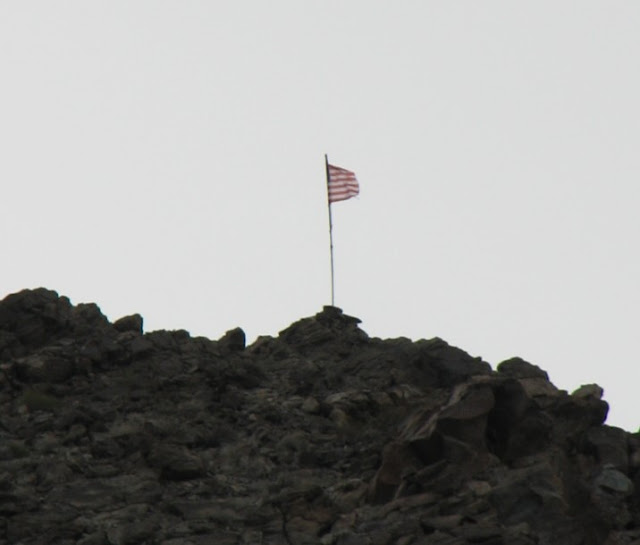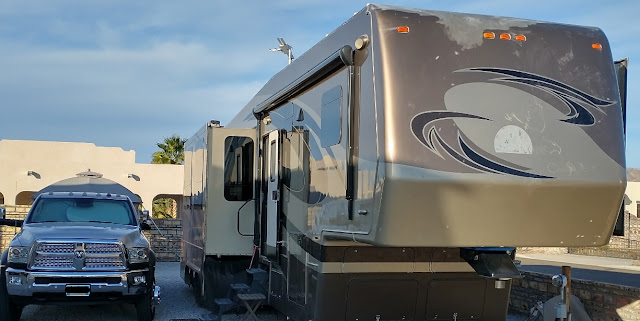Writing this post on January 8th, it already feels like February or March! Lots going on so far, and this post will hit a few highlights with us here in Yuma. What are you up to?
That's us on our spot in the Yuma Foothills of the Gila Mountain Range. We arrived just before New Year's Day on December 28th.

Romeo and Penelope all set up. We have been getting a Low Coolant message intermittently when starting up Romeo the first time in the mornings, especially when it was cold out up in Idaho. That has been going on for close to a year now, with the occurrences increasing. The message would always go off after things warmed up for a few minutes. We have kept an eye on the coolant level and it appeared full; more on that in a second. We actually got the coolant message while we were pulling down to Yuma a week ago. That was a first. We had Romeo serviced in Idaho just before we pulled to Arizona in November. We reported the low coolant message situation to the dealer and they said that they topped off the radiator coolant. We got the Low Coolant message the next day I think. Today we purchased a gallon of antifreeze/coolant from the Yuma dealer to ensure we got the correct coolant. We ended up pouring half of the gallon into the radiator overflow reservoir before the level hit the Max Fill line... so maybe the coolant WAS low! We find it hard to believe that 1/2 gallon of antifreeze went away since November. We have read on the forums that the 6.7L Ram Cummins engine does have a disappearing coolant issue... We will keep an eye on the messages and levels better now. We still have 1/2 gallon of coolant to use. The situation with the coolant overflow reservoir is that the Max and Min fill markings are confusing, and when the coolant appears to be very close to the fill lines, it can be missing 1/2 gallon as we discovered today. Our finding is that looking down into the fill spout of the overflow reservoir told the truth of where the coolant level really was. It's not easy to see in there either. a step ladder was necessary in order to get right view.

The first full moon of the year has already occurred, and it rises over the Gila Mountains below as seen looking through the masonry arch.
One of our first RV projects this year in Yuma is a slide seal repair. The seal shown below is the double wiper seal on the aft vertical opening of the bedroom slide. The rubber in that section of this seal has degenerated into a gooey mess and is coming apart more each time we run slides in and out. The opening is still sealed because it is a double wiper seal, but it is obviously time to replace this seal.

The picture below is a cross section of the seal (looking straight up from the seal bottom) that we used to identify the correct replacement part(s). It turns out our slide seals are a two part seal. The double wiper seal turned out to be an AP Products #018-2030-168, Double EKD Base w/2-3/8" wiper, 2" x 3-3/16" x 14'. Wall thickness: 1.625” - 2.375”
Black. The second part to the seal is also an AP Products part #018-312-EKD, D Seal for EKD Base,
1" x 15/16" x 35', Black. The double wiper seal is ridiculously expensive at about $17 per foot! The D seal is much more reasonable at about $0.45 per foot. We learned that replacing all the slide seals would be a $3,000 job plus! This shot below was taken from under the aft opening of the Gally slide; the same seal as the Bedroom, but is much easier to see where it hangs down unobstructed at the trailer skirting. You can see a previous repair we did to this Galley slide floor at the left side of the picture. We masked off a rectangular area and applied several coats of Flex Seal, that area appears as that wavy rectangle at the left side. I mention this because we DO NOT recommend Flex Seal for this type of repair. The Flex Seal is coming of in pieces each time we run slides in and out.

The picture below is a before photo of our front cap. The Eagle, Sun and manufacturer name and model are all stickers. The Eagle and lettering all look fine, but the Sun sticker has discolored and cracked very badly and looks horrible. We have been noticing clear coat damage growing on the front cap up at the top and have been talking about getting some paint rework done for a few years now. We either haven't made time for it or haven't had the right situation until now...

We saw some nice work on our friends John and Sharon's 5th wheel trailer. They gave us the contact information for Mario's Mobile Body Shop and Wash service. Mario and his wife Jasmine arrived one day this week and we discussed the work and reached an agreement that first visit. We liked them right away and we knew Mario does very nice work based on what we had already seen. Below he wanted to take a couple of doors that included all four paint colors to match the existing paint colors. Rather than use the original paint color mix, he said that this way the new paint would match the existing paint better if fade had occurred over the years. Jasmine is holding the water heater cover as Mario removes the small door that covers the hydraulic jack control panel. Off they went and said they would be back next week and finish the job in about 3 days.

Surprise, Mario finished his last project a couple days earlier than anticipated and popped in to begin some preparation work. Below Steve discusses planning with Jasmine as Mario and helper Johan work the cap. Mario is up high operating the orbital sander and attacking the clear coat failure area. Johan works on removing all the stickers from the cap which includes the New Horizons manufacturer name, the Majestic model name, the Eagle outline sticker and the cracked, discolored Sun sticker. We have decided that none of that will go back on, we will just go with the swirl pattern alone.
More progress...
Gari has her own questions for Jasmine.

Johan continues to work on the Sun sticker. That thing is a mess; it is coming off in small pieces. The rest of the stickers are already off and came off much more easily. The Sun sticker was looking very bad for the last year plus.

First day of prep work completed. All the stickers removed.
Isolation shot of the cap area.
Next project, replacing a shifter cable on Gari's bicycle.
The shift kit is a Shimano set up.
The picture below shows the shredded cable housing.
It turned out the rear cable housing was shredded too.
It turns out we did this the hard way... The picture below is of the bottom of the shift lever housing. We removed three small screws and the larger lag bolt in the center and opened up the shifter lever housing, thinking this was the only way to get the new cable into the housing. Big. Mistake.

That's a view inside the shift housing. Yep there were springs in there, more than one. It wasn't the way to do it, but fortunately we got everything put back in it's correct location after an hour of trying and repeatedly failing. We took a test ride of 8-10 miles and all seems to be well and back in working order.




























































